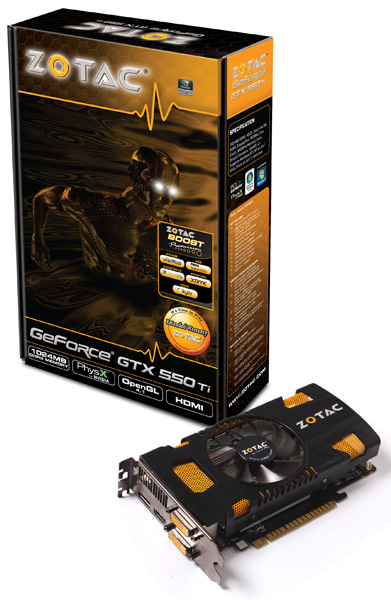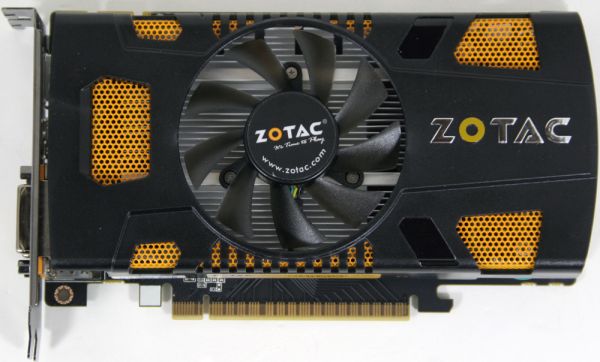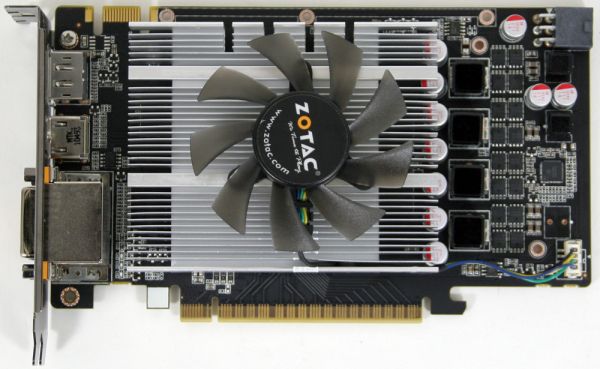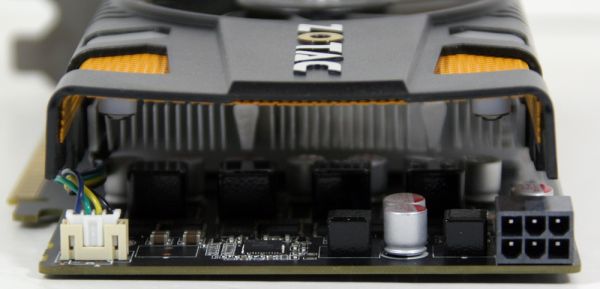NVIDIA's GeForce GTX 550 Ti: Coming Up Short At $150
by Ryan Smith on March 15, 2011 9:00 AM ESTMeet The Zotac GeForce GTX 550 Ti AMP Edition
As we stated at the start of this article, NVIDIA is not directly sampling GTX 550 Ti reference cards for this launch. Instead they have left it up to partners to do the sampling. Zotac in turn has provided us with their factory overclocked model, the GeForce GTX 550 Ti AMP, a custom design clocked at 1000MHz core and 1100MHz (4400MHz data rate) memory. We’ll be looking at performance at both stock GTX 550 and Zotac factory clocks.
The AMP is very similar in design to Zotac’s previous GTS 450 AMP card, which is not surprising given the near-perfect compatibility of the GTS 450 and GTX 550 designs. Zotac does not provide thermal/power data for their cards, but with the factory overclock we’d expect it to be a bit more than the 116W for the reference design.
At a hair under 7.5” and using a double-wide cooler design, the AMP is nearly ¾ of an inch shorter than the original GTS 450, reflecting the fact that NVIDIA’s partners often end up producing shorter cards. A simple shroud covers the card, which directs most of the airflow from the 74mm fan out the front and the rear of the card. If we remove the shroud we find a rectangular aluminum heatsink covering the GPU – the GDDR5 memory remains uncovered.
Power is supplied by a single rear-facing 6pin PCIe power socket, which provides more than enough power for a lower-power device such as the AMP. Zotac has outfitted the chip with Hynix GDDR5; 4 1Gb chips and 2 2Gb chips. All of them are rated for 5GHz operation, so even at 4.4GHz the AMP is running its memory below what the chips are capable of, not counting what the bus and GPU itself are capable of handling. Meanwhile as was the case with the GTS 450, a single SLI connector is provided for 2-way SLI.
A common theme with customized Zotac designs is support for additional display connectivity options beyond the NVIDIA reference design, and Zotac does not disappoint here. By shifting a DVI port to the 2nd slot, Zotac has outfitted the card with a full size DisplayPort, along with upgrading the HDMI port from mini to full size; they are still limited in terms of total displays by the GPU however, and even with 4 ports can only drive 2 displays at once. Zotac continues to be one of the only NVIDIA vendors we regularly see support DisplayPort, a sharp contrast from AMD & their partners who include it on virtually everything.

Rounding out the package is the usual collection of extras from Zotac. For hardware this means a molex-to-PCIe power adapter and a DVI-to-VGA adapter. Meanwhile on the software size Zotac continues to provide the Boost Premium package, which includes a collection of OEM & trial copies of various GPU-accelerated programs, including vReveal, Nero Vision, Cooliris, XBMC, and Kylo.
Zotac is pricing the card at $169 $155, $5 more than the NVIDIA MSRP for a basic card. With it comes a 2 year warranty, and a 3rd year is added upon registration.














79 Comments
View All Comments
HangFire - Tuesday, March 15, 2011 - link
For a while, AT listened and included the 8800GT with most tests. This was a great baseline as most people understood where their card fell in, compared to the 8800GT.AT has since decided (again) that all of us play nothing but the latest Dx11 games in Dx11 mode with all the goodies turned on, and the only folks upgrading already own Dx11 cards anyway.
mapesdhs - Tuesday, March 15, 2011 - link
Very true!
I've been collating performance results to compare older cards to newer
models as and when I can. Google: "Ian PC Benchmarks", it's the first link
that comes back (Blinkenlights site), then select, "PC Benchmarks, Advice
and Information". Note though that Blinkenlights is a mirror, my main site at
sgidepot is always updated first and more often.
I've included lots of 8800GT, 4890 and GTX 460 1GB data so far and I've
just obtained a 9800GT, 3850 AGP (should be a giggle!) and intend to obtain
various other older cards, including a GTX 275/285. I also have an X1950
Pro AGP (don't giggle, I got better results than reviews of the PCIe version).
Platform wise, I'm trying to put together a socket 775 build and also an
AM2/AM3 setup (I've already obtained a Core2Duo 6850 and Q6600
Core2Quad, though no mbd yet). And I'm adding further P55 examples, eg.
I've obtained an i5 670 and will be including an i5 760 aswell. All this done
on a stupid small budget btw (eBay madness), so if anyone has S775 or
AM2 parts they don't want, feel free to contact me. eBay is not exactly
bargain central anymore. :\ If you're after the highest price though, eBay
is best. Or of course free donations are welcome! 8) (I'll cover the postage;
I'm in the UK) I want to create a spread of data that will be genuinely useful
to people.
I don't have Crysis or Metro33 to test with, but I've used a good range of
freely available tests (recommendations welcome; I'm not going to use AVP
though - I had a look, thought it was rather poor). When I have the time I'll
also add real game tests using my own tests, focusing more on older titles
as that's a common issue people have (I'll be testing with Oblivion, the
1st Stalker game, CoD WAW and a few others).
I'm also including pro apps as & when I can since I do have a number of
borrowed Quadro FX cards to test aswell (580, 1500, 1700, 4500, 5500,
5600, etc.) which will all be for sale once the tests are done. So far I've
done some tests on the 1500 and 5500, but until I sort out a proper certified
X58 setup (for SLI) the results won't be fully fleshed out (Dell T7500
barebones on its way, need parts). Interesting to compare gamer & pro cards.
Note that I'm not massively familiar with older gfx cards, so suggestions are
welcome as to what I should include and/or look for. Feel free to email with
ideas (contact page is on my site, just email my Yahoo acccount). Don't post
here though as that'll only clog up the thread.
Lastly, I'm also putting together a standard X58 setup in a little while, but
first I want to sort out the older systems.
Oh, for those commenting about DX11 on older cards, that's absolutely
true, which is why whenever possible I run each test in all three modes,
ie. DX9, DX10 and DX11.
Ian.
PS. If there happens to be anybody in the Edinburgh area who has a card
they'd be willing to lend me so I can add results for it, please let me know.
You can visit and see for yourself. I'm in the Corstorphine/Clermiston area.
medi01 - Tuesday, March 15, 2011 - link
At least this time it doesn't make you color blind, and bar colors make sense (on most charts) unlike in AMD notebook review.Samus - Tuesday, March 15, 2011 - link
...but so does the GTX460. The 550 comes close to the 'stock' 460 when it is radically overclocked, just as the 460 can beat $200+ cards when it is radically overclocked.I appriciate the overclocking 'potential' and coverage, but ever since the eVGA GTX460 FTW review, AT has been dilluting the true nature of these products with overclocked cards carrying heavier weight in the charts than they should.
Your older reviews (<2009) always had a overclock section, omiting the overclocked nature from the rest of the charts. I liked that.
I just don't like seeing overclocked cards reviewed. They are limited runs and YMMV; the eVGA 460 FTW was available for less than a month after you reviewed it, and has since been replaced twice with the Superclocked, and now the Superclocked Extreme Edition, all of which has had varying GPU/BUS/MEM clocks at prices in excess of $80 over the stock cards. That's BS.
mapesdhs - Tuesday, March 15, 2011 - link
Actually the FTW is still easily available, I bought another two last week for a PC I'm
building for a friend.
Ian.
Ryan Smith - Tuesday, March 15, 2011 - link
A lot has changed since 2009. The biggest of which is that NV and AMD have both given manufacturers more freedom in their designs, and simultaneously manufacturers have been looking to further differentiate their products beyond the cooler and price. Factory overclocks are how they're doing it - it allows them to build a card with a higher performance level for little extra cost, increasing their gross margin while filling small holes in the market.Truth be told it creates a bit of a hassle for us as this results in a different card/clock combo every $10, but clearly it's an effective strategy for the manufacturers. At the same time I get why it frustrates you guys, which is why we don't include these cards on our long run charts. But when it comes to reviewing custom cards it's going to be rare to see cards without a factory overclock - most enthusiast cards now have a factory overclock, and what the manufacturers are willing to sample.
On the plus side, as mapesdhs has already noted, manufacturers are getting better about availability. These cards will never have the kind of long term availability that reference clocked cards do (largely due to the fact that it's a single supplier versus many), but many of them are available through the primary market lifetime of the card (which is to say until it's replaced by a newer GPU).
mapesdhs - Tuesday, March 15, 2011 - link
Has to be said though, I didn't expect the FTW to still be that easily available,
but it is.
However, the earlier poster is also correct that there are slightly lower clocked
alternatives from EVGA that cost less, in one case the core/shader clocks are
the same, just a bit slower RAM (the SSC version). Shop around, and note that
sometimes minor differences in prices can be negated by varying shipping costs
between suppliers. I know one company that keeps offering 'special' deals, but
their shipping costs are so high that they're usually more expensive overall than
alternative sources.
I bought the FTWs because that's what my friend wanted, basically a replica
of the system I built for myself.
Ian.
DrPop - Tuesday, March 15, 2011 - link
I love this site and all the reviews are generally very good.However, I am at a loss as to why this and all other GPU reviewers still use aged compute benchmarks such as folding @ home, etc.
Could you PLEASE start running some BOINC tests with QUALITY, optimized, MODERN code for the latest GPUs, so that the world can see the real "number crunching power" each GPU possesses?
Examples of this would be DNETC on BOINC (highly optimized), or Collatz, etc.
I am quite sure you will be surprised at how the computing bar graph will look - it will be very different than the graphs that come out of your current, aged compute code suite.
Thank you!
Ryan Smith - Tuesday, March 15, 2011 - link
It's true Dnetc is highly optimized (and I use it as a torture test because of that) but it's actually kind of a poor benchmark. It's purely compute bound to the point where cache, memory, etc have no impact. For our compute tests we want benchmarks that stress all aspects of the GPU, so that means it not only needs to be compute intensive, but memory intensive, cache sensitive, etc. Otherwise it's just a proxy for GFLOPs and a best case scenario for the VLIW5 architecture.With that said, I am completely open to suggestions. If you know of other programs that offer a decent benchmark and work on AMD and NVIDIA GPUs, I'd like to hear about it. We'll be refreshing the suite in the next couple of months, so now is the time to make suggestions.
HangFire - Tuesday, March 15, 2011 - link
At least the new 550 is marginally faster and lower power idle than the 450. Someone buying-up from one to the other will get a small boost, and even if power demands are slightly higher, the difference is so small that they shouldn't have to buy a new power supply. If they complain they didn't get a big boost, well, buy something with a larger second digit.After all the naming shenanigans Nvidia has played in the past, they should be commended for (at least) getting the name of the card right.
Memory bandwidth is a very important buying comparison for me. I only buy middle end cards with higher than 50GB/s bandwidth, and high end with more than 100GB/s. This is a form of future proofing. I know I can always turn down detail and still get the frame rates (unless it is a very poorly written game). I would settle for 98GB/s. I would not settle for 32GB/s, or some and some.
Oh, yeah, still no comment from AT on intro-time Linux driver support. Why not at least ask, why give Nvidia shelter on this point?